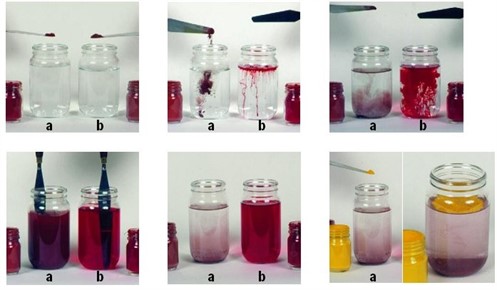Pigments vs. Dyes
Pigments vs dyes
Pigments are coloured powders that do not dissolve in the liquid with which they are mixed. They have to be regularly mixed and ground in the (liquefied) binder. Properties of the paint such as colour, tinting strength, opacity/transparency and lightfastness are determined, among other things, by the type of pigment used. If a colour-giving substance dissolves in a liquid (disintegrates such as sugar in water) we do not call the colour-giving substance a pigment but a dye.
a. Pigment - insoluble
b. Dyes - soluble
Dyes
Lightfastness and application
The lightfastness of soluble dyes in paint or ink is poor to moderate. They are therefore not used in products for artists. A painting must be seen, and light is necessary for this; the colours must therefore be durable.
For the illustrator or hobby artist lightfastness is not so important. An illustration is printed, after which the original can be kept in a dark place; children and hobby artists do not have the same requirements as artists when it comes to the durability of colours. Due to their solubility dyes are highly suited for colouring thin liquids with a particular transparency as well as transparent inks.
Soluble dyes bleed; the colour penetrates other paint layers or spreads throughout the immediate area.
Royal Talens uses dyes only in two products: Ecoline (with the exception of white and gold) and waterproof drawing ink (with the exception of white and black). The lightfastness of these products is not indicated on their packaging. Works of art produced with soluble dyes can be best stored sealed. The above exceptions are pigmented, opaque and very lightfast.

